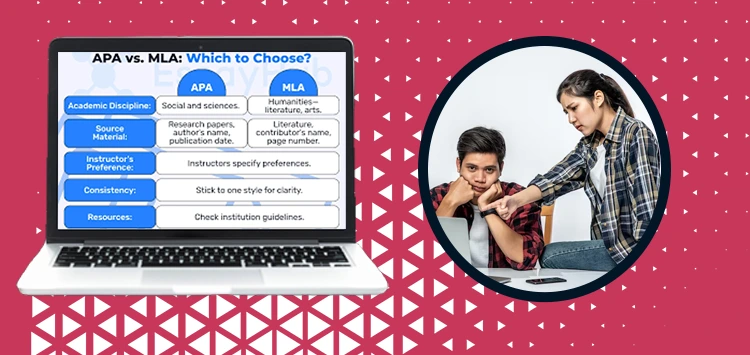APA Vs MLA Format
APA (American Psychological Association) and MLA (Modern Language Association) are two widely used citation styles, each with its own set of rules for formatting academic papers. When it comes to citing sources, APA is commonly used in the social sciences, while MLA is preferred in the humanities. Both styles require proper citation of sources to avoid plagiarism. An essential tool for students grappling with APA referencing is the APA referencing generator free, which aids in creating accurate citations. This tool streamlines the citation process, saving time and ensuring adherence to the strict APA guidelines. For additional support, students can seek Assignment Help Online, where experts provide guidance on formatting, citation, and overall assignment structure, facilitating academic success.
What Are The Key Differences Between APA And MLA Formats?
APA (American Psychological Association) and MLA (Modern Language Association) are two commonly used citation formats, each with distinct rules and guidelines. One key difference lies in the way they handle in-text citations and bibliographies. APA format typically uses the author-date citation style, while MLA relies on the author-page method. Additionally, APA emphasizes the use of headings and a structured format for papers, making it popular in the social sciences. On the other hand, MLA is commonly used in the humanities and features a more flexible approach to formatting. Both styles require a precise citation format for various sources, such as books, articles, and websites. To streamline the citation process, writers often turn to tools like a free APA citation generator, which can automatically generate accurate citations, saving time and ensuring compliance with the specific style guidelines.
How Do APA And MLA Formats Differ In Citing Sources?
When seeking assignment help, understanding the distinctions between APA and MLA formats in citing sources is crucial. Two popular citation formats with distinct requirements are MLA (Modern Language Association) and APA (American Psychological Association). APA primarily focuses on the social sciences and sciences, utilizing an author-date citation system. In contrast, MLA is often employed in humanities, using an author-page number format. While both emphasize proper attribution, they differ in aspects such as in-text citations, reference page formatting, and the treatment of online sources. A reliable assignment help provider ensures adherence to the specified citation style, recognizing the importance of accuracy and consistency. Students benefit from such services that guarantee meticulous attention to citation details, ensuring their academic work aligns with the prescribed format.
In APA Vs MLA, How Do You Format In-Text Citations?
When delving into APA essay format learning instructions for beginners, understanding in-text citations is crucial. Both APA and MLA styles serve as prominent citation methods, yet they differ in their formatting conventions. In APA, the author's last name and the publication year are essential components, separated by a comma and enclosed in parentheses. For example, (Smith, 2020). In contrast, MLA employs the author's last name and the page number, sans parentheses. A typical MLA in-text citation appears as (Smith 45). Novice writers must discern these nuances to master proper citation techniques. This foundational understanding ensures academic integrity, fostering effective communication of sources within scholarly work. As beginners embark on mastering APA essay format, grasping in-text citation nuances becomes an essential step in scholarly writing.
What Are The Similarities And Distinctions In APA And MLA Title Page Requirements?
In the realm of academic writing services, understanding the nuances of citation styles is crucial. Both the American Psychological Association (APA) and Modern Language Association (MLA) have specific requirements for title pages, ensuring scholarly uniformity. Similarities lie in the need for a clear title, author's name, and institutional affiliation. However, distinctions emerge in formatting details. APA mandates a running head and page number, while MLA opts for a header with the author's surname and page number. Additionally, APA requires a centered title at the top, followed by the author's name and affiliation, while MLA places these elements in the upper left corner. Navigating these differences is essential for academic writers providing comprehensive and accurate services in accordance with varied style guidelines.
How Does BookMyEssay Assist In Understanding APA Vs MLA Format For Assignments?
BookMyEssay serves as a valuable resource in deciphering the distinctions between APA (American Psychological Association) and MLA (Modern Language Association) formats for assignments. This online platform offers comprehensive guidance and support, aiding students in mastering the intricacies of these citation styles. Through detailed tutorials, examples, and expert assistance, BookMyEssay empowers learners to understand the nuances of APA and MLA, ensuring adherence to precise formatting rules. Whether it's citing sources, creating bibliographies, or structuring in-text citations, the platform facilitates a thorough comprehension of the unique requirements of each style. By providing accessible and user-friendly resources, BookMyEssay plays a pivotal role in enhancing students' writing skills and academic success by demystifying the complexities associated with APA and MLA formats for assignments.








 3 Bellbridge Dr, Hoppers Crossing, Melbourne VIC 3029
3 Bellbridge Dr, Hoppers Crossing, Melbourne VIC 3029



